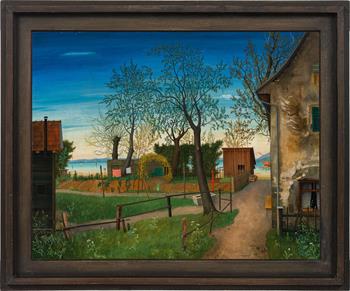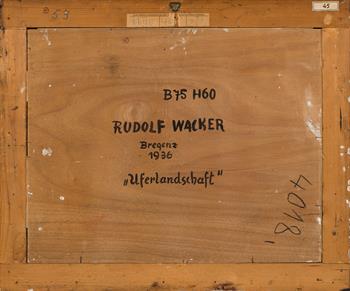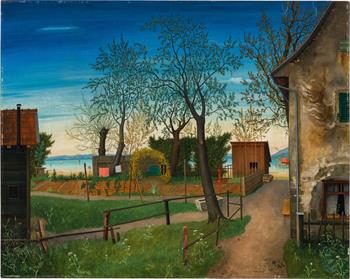0005
Rudolf Wacker
(Bregenz 1893 - 1939 Bregenz)
„Uferlandschaft“
1936
oil on plywood; framed
60 x 75 cm
signed and dated on the lower right: R. Wacker 36
inscribed by the hand of the artist on the reverse: B 75 H 60 / Rudolf Wacker / Bregenz / 1936 / "Uferlandschaft"
old exhibition label on the reverse Große Deutsche Kunstausstellung München 1937
original frame
Provenance
acquired directly from the artist in 1936;
since then family property, private collection, Austria
Exhibition
1946 Bregenz, Vorarlberger Landesmuseum, Gedächtnisausstellung Rudolf Wacker, 28.04-11.06.;
1958 Vienna, Österreichische Galerie, XLVI. Wechselausstellung im Oberen Belvedere, Gedächtnisausstellung Rudolf Wacker 1893-1939, 31.05.-28.09. (there with the title „Der Schnabelhafen bei Bregenz“)
Literature
Max Haller, Rudolf Wacker 1893-1939. Biografie mit dem Oeuvre-Katalog des malerischen Werkes, Lustenau 1971, cat. no. 327 (without ill.)
We are grateful to Dr. Jürgen Thaler, Franz-Michael-Felder-Archiv, Vorarlberger Landesbibliothek/Vorarlberger Literaturarchiv, for the precious advice and the kind assistance with the cataloguing.
Estimate: € 250.000 - 500.000
Hammer price: € 300.000
Auction is closed.
“Uferlandschaft” (“Lakeside landscape”) shows the view from Mehrerau in the direction of Lindau with the Pfänder Ridge in the background on the right. This breathtakingly beautiful view of Lake Constance, reminiscent of Old Master paintings with its precise attention to detail and bravura glazing technique, was painted during Rudolf Wacker’s final creative period in the early summer of 1936. Together with two other paintings, Wacker sent “Uferlandschaft” to the Great German Art Exhibition in Munich, which was to be held at the Haus der Deutschen Kunst (“House of German art”) in 1937. There, however, Wacker’s paintings were not selected for the show, which was representative of the art of the Nazi regime. Wacker was able to sell his “Uferlandschaft” to a Bregenz family in 1936, and the painting remained in their collection for decades. After the artist’s death, the painting was shown only twice at exhibitions: the first time in 1946 at the Vorarlberger Landesmuseum, and twelve years later at the Wacker Memorial Exhibition at the Österreichische Galerie in Vienna.
Like many of his contemporaries, Rudolf Wacker suffered increasingly from the threats emanating from the political situation in the 1930s. He sensed the threat of approaching catastrophe early on and actively took a stand against it in letters and articles. In 1937 he visited the “Degenerate Art” exhibition in Munich. In May 1938, he was subject to house searches and interrogation by the Gestapo.
The experience of nature and the landscape of his surroundings were a refuge for the painter during this difficult time and offered a way to block out the troubling present for a while. Lake Constance and its shores through the changing seasons were an inexhaustible source of inspiration for him. However, the focus on the beauty of the landscape and the banality of everyday life was only superficially light-hearted. In his diary of 1932, Wacker wrote: “When idyllic things are depicted, it cannot happen without a critical distance; we ourselves can no longer be in the idyll. We still find it, in some corner, as a remnant, as something passing away, a thing of the past – with a trace of sadness in our hearts, with a touch of mockery in our minds and with senses that are thinking into the distance beyond it.” (Rudolf Wacker, diary entry, 08.04.1932, cf. Rudolf Sagmeister, Rudolf Wacker. Tagebücher 1919-1939, Vaduz 1990, p. 604f.)
(Claudia Mörth-Gasser)




